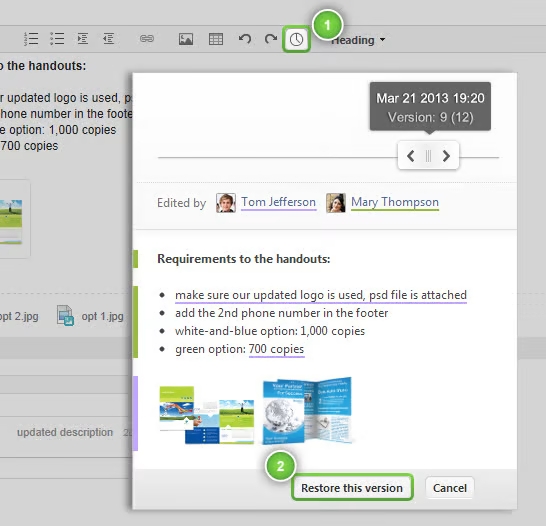Wrike and Basecamp are project management tools that make the process of organizing, delegating, and tracking tasks as simple as possible, each in its own way. While many similarities exist, like at-a-glance scheduling and simple file management, the two differ in terms of customizability and scalability.
If you’re shopping for a new project management platform, how do you choose between Wrike and Basecamp? Start by answering one question: Is your organization best served by a system built for power and customization or a straightforward system that’s easy to learn?
Keep your business’s unique needs in mind while comparing Wrike and Basecamp on task management, scheduling, collaboration, and reporting capabilities. If neither option seems like the right fit, explore other solutions in our Project Management Software Guide.
Wrike vs. Basecamp: Task management
All project management begins with task management. The easier it is to assign and manage tasks, the simpler it is to complete projects.
Wrike
In Wrike, users organize tasks under “folders” which refer to different projects. You can nest subfolders under top-level folders to better organize related tasks. Clicking on a folder pulls up an adjacent panel with a list of all tasks in that folder. Clicking on each task summons yet another panel where users can do some detailed editing — assign due dates, attach files, leave comments, track time, and add dependencies.
If you need to make changes to an entire group of tasks, you can do so at the folder level. Wrike also has search functionality at the folder level to help locate specific tasks. Folders function as a kind of dashboard: the left navigation that displays them is ever-present and acts as a filter in other views.

Basecamp
Basecamp’s approach to task management is somewhat more basic than Wrike’s folders. The platform displays tasks in to-do lists organized under their respective projects. Next to each task is the assignee’s profile picture or initials and a checkbox signifying if it’s complete or not. The to-do lists don’t offer nuanced statuses like “On Hold” or “In Progress,” which means Basecamp might be better for very small teams that can get by with just a checkbox.
Clicking on an individual task takes you to a new window where you can comment on the task, upload a file, change the due date, and otherwise edit the task. Whereas Wrike’s interface makes it possible to view one task’s details in the context of all other tasks in the project, Basecamp focuses on only one to-do list or task at a time.

Which to choose for task management?
Wrike. Here’s why: Wrike’s folder approach creates a familiar nesting visualization that stacks related tasks. The ability to quickly edit a group of project tasks also grants a lot of flexibility to teams that find themselves needing to pivot quickly. Basecamp is similar to Wrike, generally providing the same suite of tools Wrike provides but with a few features missing when looked at more granularly.
Wrike vs. Basecamp: Scheduling
The approach that Wrike and Basecamp take to scheduling is similar, but the ability to automate task dependencies and the difference between project-wide schedule views will have a distinct impact on project teams with different needs.
Wrike
One of Wrike’s most unique features is the interactive Gantt chart available in the timeline view. Using folders as a filtering tool, users can visualize each task in the folder as a horizontal bar spanning days of the week, giving project managers the ability to survey a week of work at a glance.
Users can also create and adjust task dependencies by dragging one end of the task’s bar and connecting it to another. This view can also be used for creating milestones that indicate higher-level deadlines for a project. Wrike also allows users to connect tasks directly to their calendars, making it easy to integrate visual confirmation of timelines into a team’s workflow.
The timeline view is one of Wrike’s biggest differentiators. Gantt charts are a time-tested way to visualize the moving parts of a project, and Wrike’s version gives users a substantial amount of control over tasks.

Basecamp
Basecamp’s scheduling feature displays upcoming task deadlines like a simplified digital corkboard organized on a per-month basis, which can be a little more cluttered or confusing than Wrike’s task management.
Basecamp also includes a calendar that can show project deadlines or function as a stand-alone, personal calendar. The calendar can be used to create tasks, email stakeholders who need to know about tasks, and set deadlines. Though it’s not quite on the same level as Wrike’s Gantt chart, the Basecamp calendar is a handy tool for keeping track of deadlines.

Which to choose for scheduling?
It’s a tie. Here’s why: If a team simply needs a calendar of due dates and a way to quickly knock out time-dependent tasks, Basecamp provides a streamlined and intuitive solution. On the other hand, Wrike offers the ability to not only create a calendar of work but dependencies that automate the work accountability process, ensuring team members work their way down the task list in exactly the order required to minimize delays.
Wrike vs. Basecamp: Collaboration
Project collaboration features usually come in two broad forms: collaborative updates and file management. In terms of file collaboration, both systems have native text editors, which makes tracking changes to text documents relatively straightforward, but a few key differences set the two apart.
Wrike
Wrike has several functions for activity updates — the most prominent of which is its news feed that keeps a stream of updates on all project activity, treating workflow much like the easily parsable social media timelines that workers are accustomed to. Wrike also lets you call your colleague’s attention to a particular task via email update by tagging them on the task level. Wrike also allows users to live edit documents, streamlining the process of offering critique and collaborating on complex design documents.

Basecamp
Basecamp uses a message board as the center for all of its activity updates and a centralized messaging app called Campfire. This gives teams, no matter the size, a place to slot in concerns or work-related conversation starters without clogging up email inboxes or creating distracting conversations during the workday.
Basecamp also has a client view function that lets you invite clients to a project and send them notifications. Project managers can specify what clients can see and access, thereby maintaining a level of privacy between the internal team and the external customer. Field service management and design projects that require regular input from stakeholders will find this feature useful.

Which to choose for collaboration?
Basecamp. Here’s why: Basecamp’s friendly approach to collaboration gives teams the ability to communicate with stakeholders and clients without surfacing too much internal information. They are able to do so with very little additional training. Wrike, on the other hand, requires a bit of customization and onboarding before an external party would be ready to take a peek into the more insular workspaces. Basecamp is an easy option for operations that spend much of their project time face-to-face with clients and external stakeholders while Wrike is much more well-suited to internal collaboration.
Wrike vs. Basecamp: Reporting
After a project is in motion, stakeholders need to keep an eye on progress. Strong reporting features are critical to identifying bottlenecks in the project workflow and adjusting accordingly.
Wrike
Wrike’s reporting features come in a few varieties. Filters can be used to create reports on certain types of tasks, like overdue tasks within the quarterly email campaign folder, giving project managers the ability to quickly pop into Wrike and pull information relevant to any routine check-ins.
Additionally, every Wrike folder has a burndown chart on the far right side of the screen, so teams can see how many tasks have been completed relative to how many were assigned.
A task digest view below the burndown chart visualizes all of the different types of tasks within each folder: completed, overdue, and backlog. This effectively removes the need to seek out data for reporting, as it is constantly presented to project managers.

Basecamp
Basecamp’s reporting mostly takes place in the Progress view, which shows a list of all of the completed tasks for each project in chronological order, but this reporting lacks the degree of detail and automation Wrike provides at a glance.
What Basecamp lacks in reporting and customization can easily be supplemented with its integration with tools like Gantiffy and Easy Insight. Small businesses and businesses that don’t find themselves needing to produce detailed reports for stakeholders will find Basecamp’s reporting is robust enough on its own. Should this need change, the prevalence of supplements ensures there’s an option for everyone with a little extra work up front.

Which to choose for reporting?
Wrike. Here’s why: Wrike handles its reporting without the need for additional tools. It provides a breadth of clean, robust reports that are ready to present at the drop of a hat. Basecamp’s reporting is serviceable, but it will likely require the addition of a third-party integration and extra labor spent learning how to generate reports through another service.
Wrike vs. Basecamp: Which is right for your business?
Wrike and Basecamp are two of the most popular project management tools on the market. They both offer unique advantages, so it can be difficult to determine which one is the better option.
Basecamp advantages
Basecamp’s platform is divided into several tools every productive group needs: an organizational dashboard, messaging, to-do lists, file storage, and simple scheduling. The breadth of features that Basecamp covers makes this tool an excellent fit for most project management efforts. Basecamp’s simplicity also means that the learning barriers to entry are quite low, making onboarding easier than more complicated project management tools.
Basecamp’s design is beautifully straightforward, which makes it easy to learn, navigate, and use. Basecamp comes equipped with simple boards, clean design, and integrations to other services that allow users to simply integrate their preferred productivity services like Github, Zoom, and Slack.
Wrike advantages
Wrike’s platform focuses more on power than simplicity. Its design is slightly less streamlined but can accommodate a tremendous amount of customization. The ability to create workspaces dedicated to a project that can then be broken down from the broadest view to the smallest task is an excellent organizational tool to have access to.
Wrike’s workflows are customizable from team to team, and the platform offers built-in clean visual timelines. This combination gives project managers the ability to be as particular as they like in creating and adhering to workflow structures once a project is underway. Remote teams and projects with many dependencies will benefit from Wrike a great deal.
Basecamp disadvantages
Sometimes, simplicity is not enough to shoulder the burden of complicated task management. While Basecamp shines in its ability to get out of the way of project teams, it does so at the expense of handling complexity. Large software development teams, organizations that deal with iterative design, and enterprises with a large number of interconnected teams may find that the simplicity Basecamp offers becomes messy in the face of a winding project.
Wrike disadvantages
Customization is not always the solution to project management conundrums. The power and intricacy that Wrike offers may prove to be overwhelming if a team is looking for a simple answer to an organizational roadblock. It is possible to tweak Wrike into the perfect solution, but that time tinkering and onboarding could be better spent with a more simple solution like Basecamp.
How to choose the best project management solution
Wrike versus Basecamp is a classic example of simplicity versus customization. If your team needs bespoke solutions for workflow management, then Wrike will serve you well; however, Basecamp is better suited to a broader audience of project managers with more basic needs.
That said, Wrike and Basecamp aren’t the only two options worth considering. If neither of these vendors meets your needs, explore our Project Management Software Guide or browse trending solutions below.





